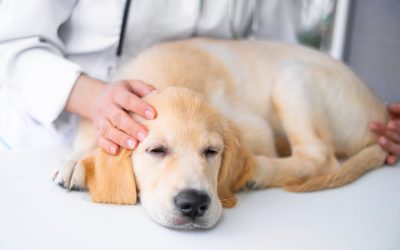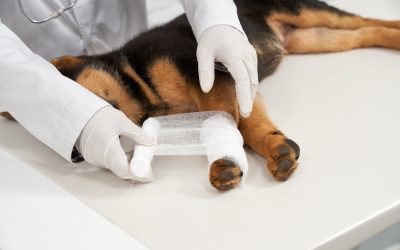Skin Cancer in Dogs [Causes, Types & Treatment]

Skin cancer in dogs can take many forms, including benign or malignant. Although some lumps may seem harmless, it’s vital to have a vet check dogs for any risks. Identifying issues early and providing quick treatment can significantly enhance success rates.
This guide will explore skin cancer in dogs. It will help you identify and address any skin lumps or growths concerning your beloved pets.
Common Types Of Skin Cancer In Dogs
Several types of skin cancer can affect dogs. Each has its traits and potential to be malignant. Here are some of the most common types:
- Mast Cell Tumors: These tumors come from mast cells, immune cells found in the skin and other tissues. Mast cell tumors can range from benign to highly aggressive and metastatic.
- Squamous Cell Carcinoma: This cancer starts in the squamous cells, which comprise the skin’s outer layer, and is often found in areas with little to no hair, such as the nose, eyelids, and lips.
- Melanoma: Melanomas are cancers that develop from pigment-producing cells called melanocytes. They can occur in the skin, the mouth, the eyes, and other pigmented areas.
- Basal Cell Carcinoma is rare in dogs and arises from the basal cells of the skin’s outermost layer. This type of cancer is more common in humans.
- Fibrosarcoma: These tumors develop from fibrous connective tissues like skin, muscle, or bone. Fibrosarcoma tumors can be aggressive and may metastasize to other parts of the body.
Causes And Risk Factors Of Skin Cancer In Dogs
Several factors can contribute to the development of skin cancer in dogs. Knowing these risk factors can help you monitor your pet’s health. You can then take preventive measures. Some of the common causes and risk factors include:
- UV Radiation: Prolonged sun exposure, especially for dogs with thin, light coats, can increase the risk of skin cancer.
- Age: As dogs age, they risk developing skin cancer, making older dogs more vulnerable.
- Breed Predisposition: Boxers, Boston Terriers, and Whippets are more prone to some skin cancers.
- Hormonal Imbalances: Some medical conditions and medications can cause hormonal imbalances. They may increase the risk of skin cancer.
- Chronic Inflammation or Skin Injuries: Skin areas with chronic inflammation or injuries may be more cancer-prone.
- Weakened Immune System: Dogs with weak immune systems may be at higher risk of skin cancer. This may be due to illness or medication.
- Environmental Factors: Certain chemicals, pollutants, and carcinogens can cause skin cancer.
Signs And Symptoms Of Skin Cancer In Dogs
Not all skin lumps are cancerous, but if you notice any of the following, seek veterinary advice:
- Lumps or Growths: Any new or changing lump or bump on your dog’s skin should be evaluated by a vet. These lumps can vary in size, shape, and texture and may or may not be accompanied by other symptoms.
- Skin Discoloration: Unusual skin color or new, changing moles. New or changing freckles or dark or light patches can indicate skin cancer.
- Sores or Ulcers: Non-healing sores or ulcers or bleeding skin
- Itching or Scratching: Excessive itching, scratching, or licking at a spot
- Swelling or Inflammation: Redness or swelling around a lump
- Foul Odor: Some cancerous tumors or ulcers may smell bad, especially if infected.
- Loss of Appetite or Energy: Advanced skin cancer can cause a decline in your dog’s appetite or energy, though it’s not a direct sign of the disease.
How To Identify A Cancerous Skin Lump On Your Dog.
Not all skin lumps are cancerous. But, you must spot signs of skin cancer in your dog. Here are some steps you can take to help identify a potentially cancerous skin lump:
- Perform Regular Skin Checks: Make it a habit to check your dog’s skin for any new or changing lumps, bumps, or growths. Pay special attention to areas exposed to the sun or prone to injury.
- Observe the Lump’s Appearance: Note the lump’s size, shape, color, and texture. Cancerous lumps may appear irregular, discolored, or have an uneven surface.
- Monitor Changes Over Time: Monitor any changes in the lump’s size, shape, or appearance over time. Rapidly growing or changing lumps may be more concerning.
- Check for Bleeding or Discharge: Lumps that bleed or ooze may be signs of skin cancer or an infection.
- Look for Accompanying Symptoms: Watch for other symptoms, such as itching, scratching, or licking at the lump. Also, note any changes in appetite or energy levels.
- Consider Your Dog’s Risk Factors: Account for any risks your dog may have, such as breed, age, or UV exposure.
Diagnosis And Staging Of Skin Cancer In Dogs
If your vet suspects a skin lump on your dog may be cancerous, they will likely recommend tests. These will confirm the diagnosis and check the extent of the disease. The diagnostic process for skin cancer in dogs typically involves the following steps:
- Physical Examination: Your vet will do a thorough exam. They will check the lump and look for any other issues or signs of cancer spread.
- Fine Needle Aspiration (FNA): An FNA uses a small needle to collect a sample of cells from the lump. This microscopic exam can help determine if the lump is cancerous or benign.
- Biopsy: If the FNA results are unclear or suggest cancer, a biopsy may be recommended. This involves surgically removing part of the lump or growth for lab tests.
- Imaging Tests: Your vet may recommend X-rays, CT scans, or ultrasounds to check the size and spread of the tumor. The tests depend on the type and extent of the cancer.
- Staging: After confirming skin cancer, your vet will stage it, determining its extent and severity. This staging process helps guide treatment decisions and provide a prognosis.
Treatment Options For Skin Cancer In Dogs
Treating skin cancer in dogs depends on several factors. These include the cancer’s type and stage, your dog’s health, and the tumor’s size and location. Common treatment options for skin cancer in dogs include:
- Surgery: The best option for localized, accessible tumors is to remove the cancerous lump. The extent of the surgery will depend on the size and location of the tumor, as well as the type of cancer.
- Radiation Therapy: Radiation therapy may be the main treatment paired with surgery. Radiation helps with tumors that can’t be fully removed.
- Chemotherapy: Chemo may treat some skin cancers, like mast cell tumors and lymphomas. It can be given orally, intravenously, or by injection and may be used alone or with other treatments.
- Cryotherapy, or freezing therapy, uses extreme cold to destroy cancerous cells. This treatment is sometimes used for small, localized skin tumors or precancerous lesions.
- Immunotherapy: Immunotherapy is a new treatment that uses the immune system to fight cancer. This approach may be combined with other treatments or as a standalone therapy for certain types of skin cancer.
- Palliative Care: Palliative care may help with advanced or metastatic skin cancer, as it can manage pain and discomfort and improve your dog’s quality of life.
How Can Pet Insurance Help You if Your Dog Needs a Treatment?
Pet insurance can be a valuable tool in managing the costs of treating a dog’s veterinary expenses. By having a pet insurance policy in place, you can have peace of mind knowing that you can provide medical care for your furry companion without worrying about the financial burden. Pet insurance can help cover the costs of veterinary consultations, diagnostic tests, medications, and even specialized treatments if required.
Reimbursement
This method is the most common for pet insurance companies. You pay out of pocket for the veterinarian bill, and then the insurance company reimburses you for what’s covered under the insurance plan. The steps look like this.
- You pay the vet bill after your dog’s visit.
- You fill out the pet insurance claim form.
- Submit the claim form and other required documentation to the insurer.
- After the claim is approved, you will be reimbursed for eligible expenses.
What Does Odie Pet Insurance Cover?
Pet insurance covers various veterinary expenses, providing financial protection and peace of mind for pet owners. Here are the details of the coverage options offered by Odie Pet Insurance:
Illness & Injury Plan
The Illness & Injury Plan is an all-inclusive insurance plan designed to cover a wide range of medical needs for your pet. This plan includes comprehensive coverage for various illnesses, injuries, and veterinary services. Some of the covered items include:
- Veterinary exams and consultations
- Diagnostics (e.g., X-rays, lab tests)
- Prescribed medications
- Surgeries and hospitalization
- Rehabilitation, acupuncture, or chiropractic treatments
- Medically necessary supplies
- Euthanasia and cremation
The Wellness Plan
The Wellness Plan is a monthly membership that focuses on preventive care and covers routine veterinary services.
- Provides reimbursements for routine care items such as wellness visits (exams and vaccines), testing and parasite prevention, dental cleanings and at-home dental care, vitamins, supplements, and more.
- Through Odie’s partnership with Petivity, a leader in smart pet products and proactive care, Wellness Plan members can also receive reimbursements for Petivity devices and health kits, as well as eligible Purina food and supplements.
- Total reimbursement up to $700 per year.



